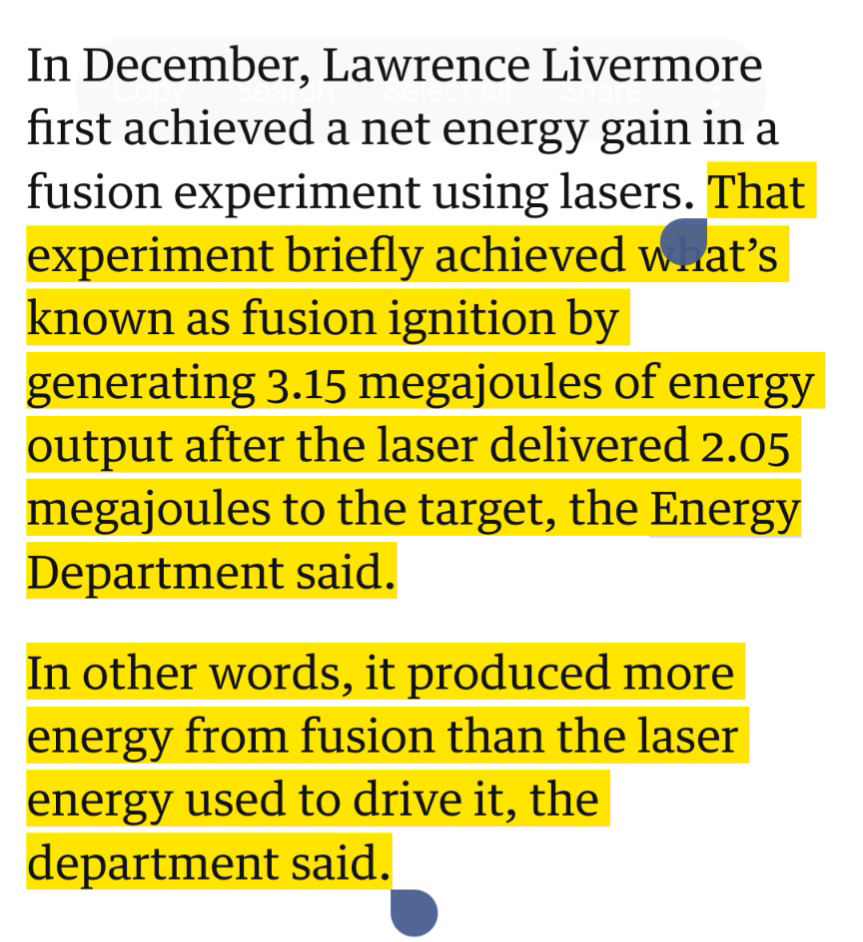This means we’ll need capture efficiency technology above 66% for this to be a net positive in terms of power generation.
For current fission nuclear power plants: “Nuclear power plant efficiency averages around 33%, which is comparable to other fossil fuel-based generation units. This means that 77% [sic, should be 67%] of the energy produced by a nuclear plant is lost and only 33% is converted into electricity. Some modern nuclear plants may be able to achieve 45% efficiency.”
This doesn’t mean anything, as it’s not actually overall net positive. It just makes for a nice headline. But it’s just that more energy than the late deposited into the pallet came out of it.
But more energy than to run the lasers or the entire facility? Far, far, far from it.
What if you used the sun as the source of the laser?
You can! And we do! In fact, then you can skip the whole fusion step, since the sun laser is already powered by fusion, and just collect the energy. I think that tech is called soul… Soul-Harp-N-L.
That’s how Supermans laser eyes work.
Still used orders of magnitude more energy to perform the experiment than the experiment output - plus they have no way to harvest that energy, and they’re mainly a nuclear weapon research facility. I guess the publicity for fusion power is good.
Still used orders of magnitude more energy to perform the experiment than the experiment output
The article literally explains that is not true. All you have to read the first paragraph.
they have no way to harvest that energy
Yes because it’s a research reactor. The first theoretical nuclear reactors also did not have any way to retrieve the energy. That’s what happens in production systems, not research systems. Adding in all of the equipment to capture the energy makes it harder to iterate on the design. It really is not a valid criticism of the research being done.
You are being somewhat disingenuous do not think.
In the 1st paragraph is a link to the previous article of the same experiment a few months ago, that has some more details mentioned:
researchers have managed to release 2.5 MJ of energy after using just 2.1 MJ to heat the fuel with lasers.
the positive energy gain reported ignores the 500MJ of energy that was put into the lasers themselves.
The article literally does not explain that’s not true, you literally have no idea what you’re talking about.
The whole point is that they put less energy into the target material than they got out of it, however much energy they had for the rest of the experiment isn’t relevant. The only part of this design that they are researching here is the fusion, everything else is supporting that research and is not been actively developed by this team.
There are other teams working on other reactor designs which increase efficiency in other areas.
It’s like saying that a rocket engine demonstration model doesn’t work because it doesn’t fly.
And the whole point of my comment is that people shouldn’t be wetting their pants thinking that fusion is right around the corner. This is just further proof of concept and does nothing to actually advance fusion power.
It’s research research advances technology that’s how it works you don’t get big huge exciting developments most of the time you get iterative development if you want big and exciting well that’s not sciences job it’s not there to entertain you. I don’t know what you want.
It’s a good example. I’d actually say test-firing a rocket and claiming you’re almost on the moon is still misleading, though.
Energy in over energy generated at the target has no practical significance. More output is better but that’s it. This is for marketing to funders.

*Edit: OK, so this article is missing a bunch of vital context. Here’s a better one: https://arstechnica.com/science/2023/08/physicists-achieve-fusion-net-energy-gain-for-second-time/
The key words are “delivered to the target”. They use WAY, way more power than they deliver to the target, so if you take the energy generated divided by the total energy used, the number is WAY, way below 1. Probably a fair bit below 0.1 too.





